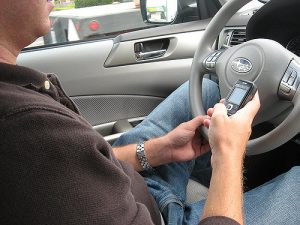Distracted Driving Study Out of Virginia Tech

Drivers engage in some secondary activity more than half of the time, this Virginia tech distracted driving study says. The hope is that people will start to realize they can’t do this safely while driving.
What we learned from a Virginia Tech Distracted Driving Study
In a distracted driving study out of Virginia Tech study this year, researchers analyzed 3,000 vehicles using cameras and data-acquisition software. The distracted driving study found that more than half of the drivers were engaged in some secondary task while driving. But beyond the obvious, the research found that drivers increase their risk of crash ten times when they are driving while sad, angry, or emotionally agitated.
The researchers put five cameras in the cars. They observed the behavior of drivers. If they were physically agitated, like they were crying or angry, the researchers would make a note. The same observation was done while looking for drivers who were fatigued.
Dr. Tom Dingus was the lead author of the study and director of the Virginia Tech Transportation Institute. “We looked at the seconds leading up to a crash or a nonevent baseline to see if we could observe the driver in a fatigued state,” Dr. Dingus said. “The analysis in the National Academy Study was strictly observed behavior. We have since looked at trying to quantify the amount of fatigue.”
Dialing a number increased the risk of crash by 12 times, according to the distracted driving study. Texting increased the risk of an accident six times. Simply reaching for a phone increased risk of a crash to three times greater than normal. Looking for a contact and browsing the Internet also increased risk of crash by three times.
“I think the purpose of this paper and the reason we do these studies is to educate drivers about doing different things while driving,” Dr. Dingus said. These activities range from texting while driving to driving while upset to driving while fatigued to driving while under the influence of alcohol or drugs, he added.
This particular research constitutes the biggest accident database in using unobtrusive video to measure crashes that is currently available. They studied how fast the car was going, how hard people were braking, how hard they were cornering, and how close they were following the vehicle in front of them. It included more than 1,600 automobile accidents ranging from low, including tire and curb strikes, to severe, including police reportable accidents. The drivers in the study participated in between one and two years of research.
“If drivers are aware, they would delay starting another trip or find a place to pull over,” Dr. Dingus said. “That would be our hope.”
Out of the 905 higher severity accidents involving personal injury or property damage, factors related to the driver of the vehicle, such as fatigue, error, impairment, and distraction, were present in 90 percent of the accidents.
“We had trained observers classify the data,” Dr. Dingus said. They had inter and intra rater reliability well above 90 percent, he said. This is the degree to which there is agreement between different raters and in a single rater.
Moving a vehicle at a speed significantly greater than the speed limit significantly increases chance of crash about 13 times the normal rate, according to the distracted driving study. In addition, errors in driving a vehicle, including not braking appropriately or not being accustomed to the car or road, increase the risk as well.
This is the largest study ever funded by the National Academy of Science, Dingus said. People can put in persuasion techniques, laws in the case of distracted driving, and safety features like automatic braking, he added. More than $50 million has been awarded to the Virginia Tech Transportation Institute from the National Academy of Sciences.
“The Virginia Tech Transportation Institute continually advances transportation through innovation and has impacted public policy on the national and international level,” the Virginia Tech news article stated. The stated purpose of the Institute in the Virginia Tech news article was to conduct research “to save lives, time, money, and protect the environment.”
Dr. Dingus said that we kill 90 people every day, including 30 teenagers, on the road. “You compare that to other tragic events around the world, the Egypt plane crash kills 66 people, we kill that many every day,” he said. Zero people died in shark attacks, he noted, but it was in the news because people were attacked. We kill 90 people every day, but it wasn’t in the news, he said. “That’s why we do this kind of work because we kill a lot of people,” Dr. Dingus added.
He said that it really helps to educate the public. That’s why Dr. Dingus and his colleague Mindy Buchanan-King wrote the book, “Survive the Drive: A Guide to Keeping Everyone on the Road Alive,” to talk about crash risks of all kinds and how people can reduce their risk. The book incorporated many years worth of research into one guidebook for people of all ages to comprehend and manage their daily risk of crash.
The fatality rate has decreased substantially even though people are driving more, Dr Dingus explained. “The goal is zero fatalities on our roadways eventually,” Dr. Dingus said. “We’ve made a lot of progress.”